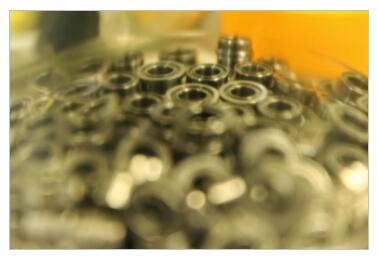Welcome to Sino Bearings web
24x7 HOTLINE:+86-28-81454188

 NEWS
NEWS
Chris Johnson explains a different kind of load – and how a bearings ability to deal with it can help maximise bearing longevity
We’ve all tried it – carrying all of our shopping bags from the weekly food shop into the house in one go, just to avoid an extra trip out to collect the rest.
While our arms can deal with an extra heavy load once in a while, industrial bearings generally can’t cope with being overloaded with weight.
Most bearing manufacturers agree that approximately 10% of bearing failure is caused by an unsuitable choice of bearing in either design, size or load carrying capacity.
Such failure can cause significant damage to the bearing and the machine, which can be extremely costly for a plant manager.
Given that the global market for bearings is predicted to reach $83.3 billion by 2020 correct estimation of bearing load is no small matter.
Deceptive data
Choosing a bearing should be simple.
“The size of a bearing for any application may be decided on the basis of its load carrying capacity in relation to the loads to be carried and the requirements regarding life and reliability. Generally, the basis static load rating and basic dynamic load rating are used to express the load carrying capacities of any bearing,” explains Ganesh Babu in his book Design of Machine Elements.
The catch is that the decision depends not only on knowing the demands of the application, but also understanding the way the bearings are rated in the first instance.
As well as their size and material, bearings can be categorised under their dynamic radial, static radial and axial load rating. However, these ratings can often be deceptive.
For example, a dynamic load rating indicates the capacity that a bearing can endure for one million inner ring rotations before the first signs of fatigue or damage develop.
While one million rotations sound like a lot, for a bearing operating at around 5,000 revolutions per minute (rpm), with the maximum dynamic load applied to it, one million ring rotations would be completed in just over three hours.
Therefore, unless plant managers and maintenance engineers are happy at the prospect of replacing their bearings every few hours, they should understand that the dynamic radial load rating gives the absolute maximum load a rotating bearing can endure for a short period.
Realistically bearings should not be subjected to anywhere near these loads in normal applications.
To get the best life ratings from your bearings, limit the actual load to between six and twelve per cent of the bearing’s dynamic load rating. This load rating varies according to bearing material. For example, stainless steel bearings will support approximately 80 to 85 per cent of the load figures indicated for chrome steel bearings.
Overbearing weakness
When excessive loads are inflicted on a bearing, the bearing steel will experience premature fatigue.
Sub-surface cracks will occur, which will eventually spread to the bearing raceway in the form of flaking, also known as spalling. This is usually accompanied by a heavy ball wear path and will put your whole system at risk.
The first signs of damage will typically be increased noise and vibration and a significant increase in bearing temperature leading to overheating.
Excess loading can also be caused by insufficient internal clearance. If the residual play in the bearing is reduced too much by tight shaft or housing fits, the bearing will be overloaded.
The same can occur as a result of an out-of-round shaft or housing or an excessive axial preload.
Static radial overloading can also cause problems. A weight that exceeds the bearing’s static load capacity will cause the balls to make indentations on the raceway. This is known as brinelling and will greatly increase vibration and drastically shorten bearing life.
A very high static load can also occur if the bearing, or the component in which it is mounted, is dropped or an incorrect fitting procedure is used.
Long-life loading
To increase the potential life cycle of your bearings and avoid unnecessary shut down of systems, selecting a bearing that will adequately handle the expected loads is of upmost importance.
Avoid sudden impact loads, pay attention to bearing internal clearance, check shaft and housing roundness and remember that running the bearing at not more than 12% of its dynamic load rating will provide optimum bearing life.
Speaking to bearing experts can help you extend bearing lifecycle while achieving the maximum potential of your bearings, resulting in fewer maintenance issues and lower replacement costs.
When selecting the bearing to best fit your needs, it’s important to remember that inappropriate loads cause increased fatigue and risk of bearing failure.
Just like when your arms get tired during heroic efforts to carry a weeks’ worth of food into the house in one go.
The difference is that tired arms don’t cost hundreds or thousands of pounds in plant maintenance or hundreds of thousands in downtime.
Chris Johnson is managing director of specialist bearing supplier, SMB Bearings.